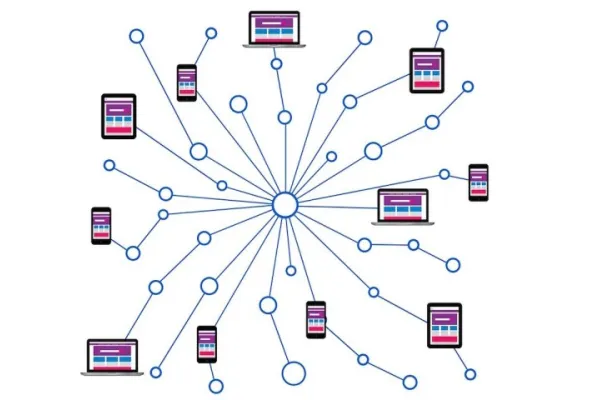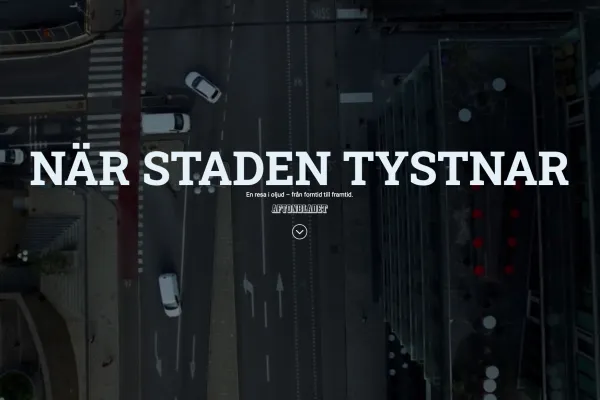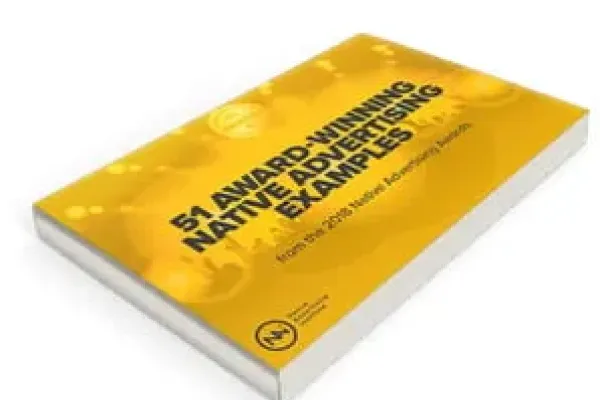
 Details
Details
Where PPC and display advertising were good at distributing salesy mid- to bottom-funnel content, programmatic native advertising proved good at distributing helpful or entertaining (non-salesy) top-funnel content.
Native advertising has been around for over 100 years. It’s existed on most of the different media types in one form or another through generations of marketers and advertisers. From newspapers and magazines, to radio and television; some of the world’s most iconic brands have invested in native advertising.
That said, it’s mostly been considered a niche endeavor in the budgets of most marketers and advertisers through last century. However, in the 90’s companies like Google, Yahoo and a few others introduced us to a new form of native advertising (according to the Interactive Advertising Bureau’s six categories of native advertising) – paid search ads, also known as pay per click (PPC), on the Internet.
A brief history of programmatic native ads
PPC joined display advertising as one of two of the major forms of paid media on the Internet during the 90’s and last decade. These channels did a pretty good job at delivering mid- to bottom-funnel content to the audiences brands wanted to speak to.
READ MORE: The Best Programmatic Native Ad Platforms Right Now
It was in the mid-2000s that brands started to discover content marketing. This can loosely be defined as the creation and distribution of top-funnel content to build an audience. This time frame can also be described as the infancy of present-day programmatic native advertising.
Where PPC and display advertising were good at distributing "salesy" mid- to bottom-funnel content, programmatic native advertising proved good at distributing helpful or entertaining (non-salesy) top-funnel content. So good, in fact, that projected growth in programmatic native advertising spend by media buyers, marketers and advertisers is expected to grow rapidly in conjunction with increased publishing by content marketers.
RELATED: How Book App Increases Downloads with Content Recommendation
In addition, programmatic native advertising tends to cost much less than the previously mentioned lower funnel paid distribution channels. Rightfully so, as no marketer wants to spend the same or more per click or action at the top of the funnel than what they pay at the bottom of the funnel.
It’s this present-day dynamic that’s moving programmatic native advertising from a niche endeavor in many budgets to a major channel for content distribution online. Much of this growth is happening on Facebook and other social media channels.
Types of programmatic native advertising
While many of the social media networks do indeed offer programmatic advertising solutions, the industry generally separates social media native ads from programmatic networks like Taboola, Outbrain, Adblade, Revcontent, Gemini etc. For the purposes of this article, we’ll separate them, too.
Generally speaking, there are three types of native programmatic solutions:
- Native social media – Not all social media advertisements are considered native. Ads located “in-feed” are considered native. The ad units must exist in the organic newsfeeds of the networks and are generally labeled as sponsored.
- Programmatic native networks – This form of distribution is found on publishers’ websites and delivers/recommends advertisers’ top funnel content. They also are generally labeled as sponsored and are placed in the organic article feed, below an article, right or left side rail (with other organic content), or in the app of a publisher.
- Managed services technology – While working directly with networks has its advantages, using a dozen or more of them can be difficult to manage. Over the last few years. several start-ups have launched to help solve this problem. These solutions provide one user interface to empower advertisers to tap into up to 30 networks and social media platforms at a time. They also provide normalized analytics to accurately compare and contrast performance across networks. Many of them also offer some level of service and management.
Programmatic native advertising offers media buyers, advertisers and content marketers the newest form of online paid media to promote and distribute content.
READ MORE: How to Spot Native Ads
Programmatic native advertising definition
Programmatic native advertising offers media buyers, advertisers and content marketers the newest form of online paid media to promote and distribute content.
This form of digital advertising, when done right, mimics the overall look, feel, and format of whatever publication, blog or social media network it appears on. It seamlessly blends in with its surroundings.
RELATED: The Native Ad Tech Landscape Is Growing at Rapid Pace
By doing so, this form of native advertising enhances a user’s experience instead of disrupting it. What separates programmatic buying from non-programmatic buying is the use of some combination of sophisticated automation, algorithms, machine learning, artificial intelligence, and/or natural language processing in order to maximize performance and minimize spend.
This represents a vast improvement over the trial and error methods deployed for older online paid media solutions. It’s empowered marketers, advertisers, media buyers, and, yes, even publishers, to find a new level of scalability in driving key performance indicators (KPIs).
READ MORE: What Is an Advertorial?
Best practices for programmatic native advertising
While every network, social platform and managed services technology each has its own best practices and tactical do’s and don’ts, they still share the same principles for success. Below is an outline for best practices when using the three forms of programmatic native advertising discussed above.
1. Identify your goals
Generally, B2B and B2C marketers tend to have different goals. Many B2C brands are focused on awareness KPIs. This can be a proprietary measure of their share of voice (SOV) or something more concrete such as traffic or time on site.
For B2B marketers, awareness is important but they are generally looking for engagement and conversions as well. Identifying, measuring and tracking these KPIs are commonly considered imperative for them.
RELATED: How to create a native advertising strategy
According to TripleLift, native ads drive three times higher brand awareness and purchase intent, deliver 250% higher ad engagement, and lead to conversions that drive a 475% return on ad spend. The goal or goals that are chosen will help craft creative, execution, targeting and measurement.
2. Story sequencing
As stated above, native advertising is really good at delivering top-funnel content at scale. However, through story sequencing, it’s possible to use programmatic native advertising the same way marketers use lead nurturing.
In its simplest form, story sequencing ensures that only people who engage with top-funnel content are later delivered mid-funnel content via programmatic native or retargeting. It also makes sure that only people who engage with mid-funnel content are later delivered bottom-funnel content via native or retargeting.
RELATED: 3 Data Myths that Native Advertisers Need to Stop Believing
Story sequencing aligns content and its distribution with the buyer’s journey. This can be prudent for both B2B and some B2C brands. It’s mostly dependent on the goals of the campaign. Below are the six steps in story sequencing:
- Identify content assets to distribute
- Organize content by persona (target audience(s))
- For each persona, organize content by buyer’s journey stage
- Note missing content and develop
- Map the content workflow
Execute programmatic native advertising with prudent targeting and story sequencing parameters.
Methods of targeting will be dependent on the type of company doing the campaign, goals, KPIs and budgets.
3. Target wisely
Each social media platform, network and managed services technology has some or all of the targeting capabilities mentioned below. Methods of targeting will be dependent on the type of company doing the campaign, goals, KPIs and budgets.
Methods of targeting
- Context: Domain and Page Level – This method of targeting is pretty straightforward. In most cases, it makes sense to have the context (topic) of the content being distributed match the context (topic) of the organic content surrounding it (whether at the macro domain level or at the micro page level).
- Audience: User Level (UPD), Demographic, History, Interests, Retargeting, Lookalikes – One of the most commonly deployed methods of targeting across most forms of digital advertising includes this category. As a result, it’s not necessary to go into detail on each in the category. That said, lookalikes are the newest and least known method of targeting. It’s very popular with social media advertising. Generally, advertisers will take an existing email list of customers and upload it to the network. The network will then look for those individuals and take note of similar attributes across the list. Afterwards, it will target “lookalikes” with similar attributes to the list that was uploaded. It’s also possible to target the list itself.
- Day-Parting: Time of Day, Day of Week – This is pretty self-explanatory. Depending on the industry and type of company there can be massive value in targeting via time.
- Geo-Location: Country, State, DMA – Again, self-explanatory. Businesses with geo-location limitations or geo-divided sales territories may find this method of targeting highly beneficial.
- Device Type: Desktop, Tablet, Phone – Content format and consumer behaviour generally drives this type of targeting. Also, it may be prudent to make unique content for each device type targeted. Although, many programmatic native ad solutions and the publishers they’re partnered with have responsive capabilities to handle these different devices.
- Weather-Triggered – Depending on the content, products and services offered by a business this can be a lucrative way to target. Companies that sell products or services around snow, rain, sunny summer days, etc can get their content in front of an audience experiencing these weather conditions in real time.
It’s important to remember that the more targeting parameters used. the smaller the audience generally. That’s not necessarily a bad thing but is worth noting because no matter how perfectly targeted the audience is it needs to be a certain size to hit KPIs and goals.
There are other new native experiences and targeting parameters on the horizon. With the emergence of virtual reality, augmented reality, the Internet of Things, and wearable technology, it’s likely that advertisers will be able to deliver content into mobile, desktop, virtual or augmented environments targeted based on actual emotions. With heart rate, blood pressure and other bio-measurements being tracked and connected to the Internet this is certainly in the realm of possibility sometime in the future.
When setting up campaigns, it’s important to align execution with goals.
READ MORE: How to drive results with sponsored posts on Facebook
4. Be careful with terminology
When setting up campaigns, it’s important to align execution with goals. These parameters are set up in the user interface of the network. If traffic to a particular company webpage is the goal then having a Facebook campaign charging for clicks, likes and shares, doesn’t make sense. In this example, money spent on likes and shares doesn’t align with the goals of the campaign.
RELATED: Succed with Paid Posts on Instagram with this guide
With native social advertising, actual website traffic can be as little as one-sixteenth of the actions paid for. That means that the vast majority of the budget can be wasted if the correct parameters aren’t established in the beginning.
A/B or multivariate testing is a staple for many successful programmatic native advertising campaigns.
5. Experiment
At its core, all marketing and advertising is an exercise in experimentation. Practitioners use research and data to more accurately predict results, but it is still an ongoing experiment – programmatic native advertising is no different. As a result, analyzing and adjusting campaigns based on performance and analytics over time is critical for success.
A/B or multivariate testing is a staple for many successful programmatic native advertising campaigns. This is a form of constant experimentation and KPI/goal optimization.
It can also be highly lucrative to consider some outside-the-box experiments. For example, rather than targeting the identified ideal personas, maybe run a small pilot targeting the journalists or influencers those ideal personas read or follow. Getting influencers engaged with, talking about or sharing distributed content could prove to have a major amplification effect. In this way, advertisers can use paid media to earn media.
READ MORE: How to Write the Best Headlines for Native Ads
6. Pay attention to creative
One of the biggest challenges facing programmatic native advertising as an industry today is the proliferation of click-bait spammy articles in pursuit of impressions for ad revenue. Many of these have been labelled as “fake news” by mainstream media outlets and are distributed using programmatic native. (This topic could be multiple articles unto itself).
I trust that no one reading this intends to or is currently deploying these methods. As a result, the below checklist is designed to help advertisers and marketers alike avoid any perception of being a part of the grey/black hat, “fake news” content community.
It’s also designed to help ensure marketers, advertisers, media buyers and publishers are adhering to best practices that will ultimately make them more successful.
Optimizing native creative elements
- All creative, including the landing page, should be seamless.
- Leverage dynamic headlines for context and personalization.
- ABT – Always Be Testing native ad units using A/B and multi-variate testing methods.
Optimizing native ad images
- Use faces
- Incorporate familiar imagery
- Use brand-appropriate colours
- Be transparent
- Trigger emotions
Native ad headline best practices
- Be honest
- Be concise
- Don’t sell
- Tell a story
- Be transparent
- Consider the call-to-action
- Use numbers
- Use adjectives
- Be relevant
The above topics represent what all media buyers, marketers, advertisers and publishers should know about programmatic native advertising as a broader tactic. Of course, each network, social media platform and managed services technology could have its own article that gets precise and granular when describing the top tactics, execution techniques and strategies.
Native advertising has had a long history with advertisers, marketers and publishers. Current trends suggest that it’s quickly moving from a niche line item in a budget to a major investment in advertising. There’s no reason to believe otherwise. That said, programmatic native advertising is still in its infancy and the surface has only been scratched on what it will look like tomorrow.
READ MORE: Visual Ads Masterclass: 8 Essential Visual Techniques for Advertising




